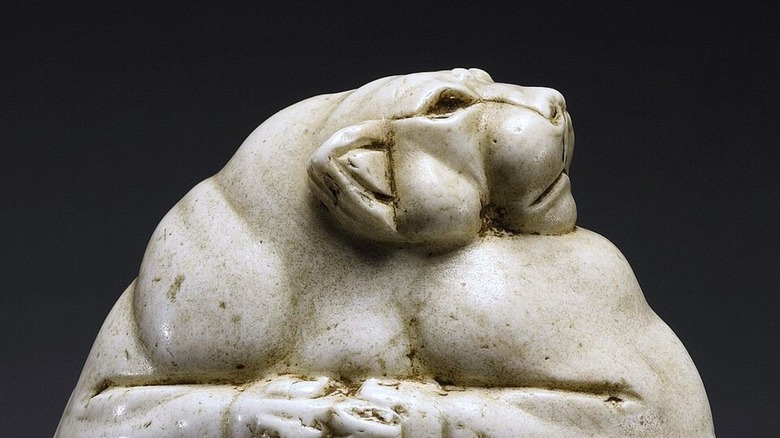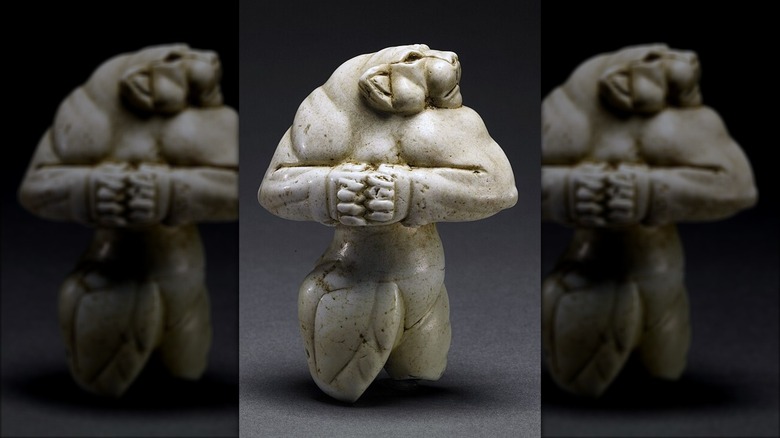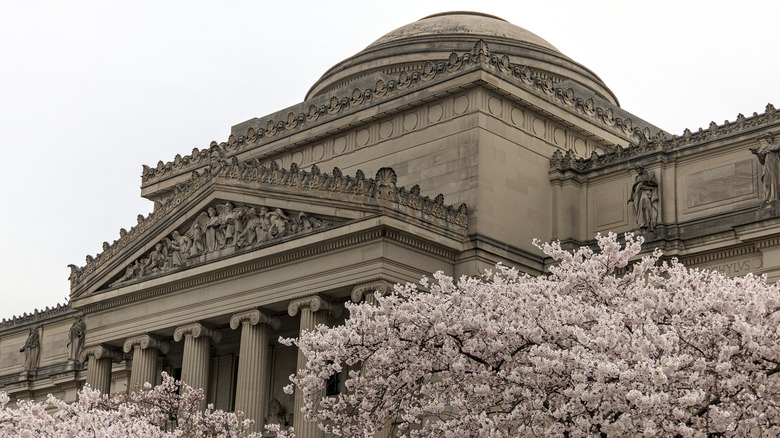This Rare Lioness Statue Is The Most Expensive Ancient Artifact Ever Sold
For most people, antiquing is a wholesome, low-stakes hobby through which you might uncover an affordable and evocative slice of history. Antique dealerships and markets are often quaint, charming places with a family-run vibe and a friendly atmosphere. Yet such businesses often deal in relatively low-value goods. Indeed, many times the wares you find in antiques stores aren't antiques at all — they're just old. But when it comes to extremely rare items, especially artifacts from the ancient world, things can get very serious indeed.
Take, for example, the so-called "Guennol Lioness," a stunning 5,000-year-old work of ancient art that to this day mystifies scholars and is spoken of in hushed tones by collectors and historians. The object, which stands at just 3.3 inches in height and is made from limestone, is considered a masterpiece of craftsmanship. Its exquisite shape was formed by an unidentified artist around the time that humanity created the wheel.
It's not known when it first arrived on the art market and how it came into circulation among dealers. Some experts suggest that some shady dealings may be behind its commodification. Nevertheless, the Alastair Bradley Martin Fund auctioned the Guennol Lioness at Sotheby's New York on December 5, 2007, and the winning bid from a private British collector came in at an eye-watering $57,200,000 (around $88 million today). It remains the single largest amount ever paid for an ancient artifact.
What does the Guennol Lioness represent?
The form of the Guennol Lioness is immaculate and strange, and it certainly raises questions as to how a craftsperson working five millennia ago could possibly have made it. It shows a perfectly rendered leonine head atop a rippling body that appears more human than animal. When it went up for sale in 2007, the auction house Sotheby's described the statue in its listing: "[A] powerful form and monumental conception, striding with the left leg advanced, the broad-shouldered upper body turned fully to the right with the paws clasped to the abdomen, the head with finely incised detail, and wide-set eyes with circular pupils, four holes on the back for insertion of a tail, two holes on the crown of the head perhaps for suspension, the lower legs possibly once completed in a different material."
Commentators have suggested that the anthropomorphic figure is more than simply a lioness and is also a representation of the lioness figure in astrology. She is a symbol of strength and fertility, especially in the summer months, which is the animal's mating season. The fact that the Guennol Lioness exhibits a hole at the top indicates it was likely an amulet, possibly worn around the neck of a hugely wealthy and important figure of the ancient world. They would have hoped the lioness offered them protection while also serving as a symbol of their status in society. Still, while many famous statues are known to contain hidden messages, the fact is that much of the meaning around the Guennol Lioness is likely yet to be uncovered.
The provenance of the Guennol Lioness
The Guennol Lioness is believed to be Proto-Elamite in origin, meaning that it was likely made in what is modern-day Iran. Formerly Elam, the civilization is perhaps better known for its intricate writing system. The Proto-Elamites have been described as master sculptors, especially of animal figures, which may have been valuable commodities along the trade routes of the period. As well as the Guennol Lioness, other examples from the period include a reclining goat, a standing ibex, and an anthropomorphic kneeling bull holding a drinking vessel, all of which are rendered in silver.
The Sotheby's listing notes that the Guennol Lioness was discovered somewhere near Baghdad, but this appears to be unverified. Some sources claim the statuette passed through the hands of British archeologist Leonard Woolley before becoming the property of art dealer Joseph Brummer in New York in 1931. By 1948, it was acquired by Alistair and Edith Martin.
The Lioness gets its name after the couple: The Martins had Welsh heritage, and "Martin" translates to "Guennol" in Welsh. Despite the Guennol Lioness being their private property, they have loaned the statuette out to the Brooklyn Museum, where Alistair worked for almost 60 years. Lucky for the public, as they too can wonder at the incredible detail of ancient Proto-Elamite sculpture.


